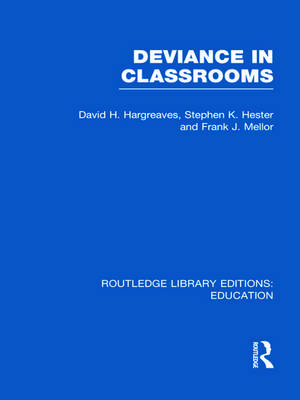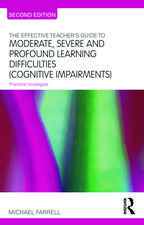Deviance in Classrooms (RLE Edu M): Routledge Library Editions: Education
Autor David Hargreaves, Stephen Hester, Frank Melloren Limba Engleză Hardback – 8 dec 2011
Din seria Routledge Library Editions: Education
-
 Preț: 379.49 lei
Preț: 379.49 lei -
 Preț: 400.94 lei
Preț: 400.94 lei -
 Preț: 377.16 lei
Preț: 377.16 lei -
 Preț: 379.32 lei
Preț: 379.32 lei -
 Preț: 401.34 lei
Preț: 401.34 lei - 8%
 Preț: 382.25 lei
Preț: 382.25 lei - 18%
 Preț: 1332.87 lei
Preț: 1332.87 lei - 34%
 Preț: 819.90 lei
Preț: 819.90 lei - 27%
 Preț: 247.40 lei
Preț: 247.40 lei - 36%
 Preț: 819.90 lei
Preț: 819.90 lei - 36%
 Preț: 819.90 lei
Preț: 819.90 lei - 36%
 Preț: 819.90 lei
Preț: 819.90 lei - 36%
 Preț: 991.00 lei
Preț: 991.00 lei - 36%
 Preț: 822.76 lei
Preț: 822.76 lei - 36%
 Preț: 821.53 lei
Preț: 821.53 lei - 29%
 Preț: 259.98 lei
Preț: 259.98 lei - 34%
 Preț: 764.20 lei
Preț: 764.20 lei - 36%
 Preț: 819.90 lei
Preț: 819.90 lei - 36%
 Preț: 761.85 lei
Preț: 761.85 lei - 36%
 Preț: 986.91 lei
Preț: 986.91 lei - 55%
 Preț: 541.50 lei
Preț: 541.50 lei - 36%
 Preț: 762.01 lei
Preț: 762.01 lei - 27%
 Preț: 261.37 lei
Preț: 261.37 lei - 36%
 Preț: 764.20 lei
Preț: 764.20 lei - 36%
 Preț: 762.97 lei
Preț: 762.97 lei - 36%
 Preț: 819.90 lei
Preț: 819.90 lei - 36%
 Preț: 986.91 lei
Preț: 986.91 lei - 36%
 Preț: 821.53 lei
Preț: 821.53 lei - 36%
 Preț: 819.90 lei
Preț: 819.90 lei - 36%
 Preț: 819.90 lei
Preț: 819.90 lei - 36%
 Preț: 821.13 lei
Preț: 821.13 lei - 38%
 Preț: 2100.27 lei
Preț: 2100.27 lei - 36%
 Preț: 819.90 lei
Preț: 819.90 lei - 36%
 Preț: 819.90 lei
Preț: 819.90 lei - 36%
 Preț: 764.20 lei
Preț: 764.20 lei - 36%
 Preț: 819.90 lei
Preț: 819.90 lei - 36%
 Preț: 986.91 lei
Preț: 986.91 lei - 36%
 Preț: 764.20 lei
Preț: 764.20 lei - 36%
 Preț: 819.90 lei
Preț: 819.90 lei - 36%
 Preț: 4048.76 lei
Preț: 4048.76 lei - 36%
 Preț: 736.38 lei
Preț: 736.38 lei - 36%
 Preț: 819.90 lei
Preț: 819.90 lei - 36%
 Preț: 821.53 lei
Preț: 821.53 lei - 36%
 Preț: 819.90 lei
Preț: 819.90 lei - 36%
 Preț: 819.90 lei
Preț: 819.90 lei - 36%
 Preț: 819.90 lei
Preț: 819.90 lei - 36%
 Preț: 819.90 lei
Preț: 819.90 lei - 36%
 Preț: 819.90 lei
Preț: 819.90 lei
Preț: 823.17 lei
Preț vechi: 1283.70 lei
-36% Nou
Puncte Express: 1235
Preț estimativ în valută:
157.52€ • 171.79$ • 132.82£
157.52€ • 171.79$ • 132.82£
Carte tipărită la comandă
Livrare economică 24 aprilie-08 mai
Preluare comenzi: 021 569.72.76
Specificații
ISBN-13: 9780415689472
ISBN-10: 0415689473
Pagini: 294
Dimensiuni: 156 x 234 mm
Greutate: 0.64 kg
Ediția:1
Editura: Taylor & Francis
Colecția Routledge
Seria Routledge Library Editions: Education
Locul publicării:Oxford, United Kingdom
ISBN-10: 0415689473
Pagini: 294
Dimensiuni: 156 x 234 mm
Greutate: 0.64 kg
Ediția:1
Editura: Taylor & Francis
Colecția Routledge
Seria Routledge Library Editions: Education
Locul publicării:Oxford, United Kingdom
Public țintă
General, Postgraduate, Professional, and UndergraduateCuprins
Preface. 1. A Critical Introduction to Labelling Theory. 2. Deviance and Education. 3. Rules in School. 4. Rules in Context. 5. The Imputation of Deviance. 6. A Theory of Typing. 7.The Typing of Deviant Pupils. 8. Reactions to Deviance. 9. Some Implications. Notes. Bibliographical Index. Subject Index.
Descriere
When originally published this book reported the first major application of ‘labelling theory’ to deviance in classrooms. The authors explore the nature of classroom rules, show how they constitute a pervasive feature of the classroom, and examine the ways in which teachers use these rules as grounds for imputing ‘deviance’ to pupils. A theory of social typing is developed to show how teachers come to define certain pupils as deviant persons such as ‘troublemakers’ and several case-studies are used to document this analysis. Finally, the teachers’ reactions to disruptive classroom conduct are examined as complex strategic attempts at social control in the classroom. The book has a double focus on deviance theory and the process of teaching.












